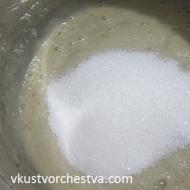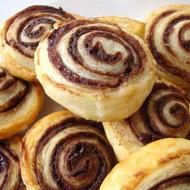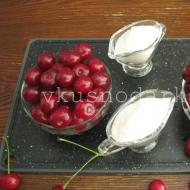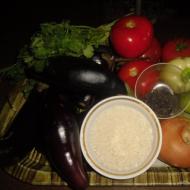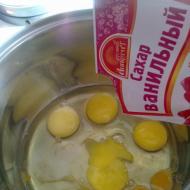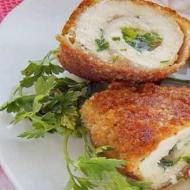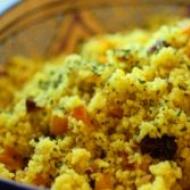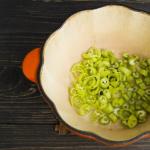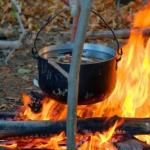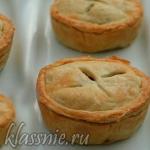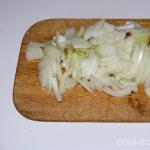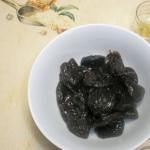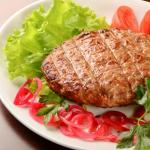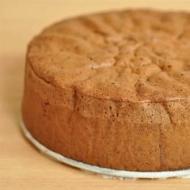
Pecorino cheese: what is it and what can it be replaced with? What is pecorino cheese? Romano cheese
Pecorino Romano is a cheese made from sheep's milk (Caprino Romano is made from goat's milk, Vaccihino Romano is made from cow's milk). Traditionally, this cheese has a cylindrical shape; cheese diameter 20 cm, height 30 cm, weight 5.5-22 kg.
It has a smooth, straw-colored crust that may be coated with oil or a yellow clay paste.
The cheese dough is white to straw-colored, the structure is dense, rough, usually without eyes.
The taste and aroma of the cheese is spicy, depending on the type of milk. To make cheese, raw sheep's milk with a fat content of 6.8% or higher is used.
Homemade Pecorino Romano cheese recipe
Ingredients:
- sheep milk - 10 l
- thermophilic bacterial culture - ½ teaspoon (2.5 ml)
- liquid enzyme - ¼ teaspoon (1.25 ml)
- cold rich
- Olive oil
How to make Pecorino Romano cheese at home:
Prepare, wash and sterilize all tools and equipment. In a sufficiently large stainless steel container, heat the milk to 32ºC.
Sprinkle the bacterial culture onto the surface of the milk and let it soak for 5 minutes. Mix the milk thoroughly, being careful not to form air bubbles. Soak the milk with the bacterial culture for 15 minutes, maintaining the temperature at 32ºC.
Dilute in 50 ml of cold water. Add the enzyme to the milk and mix using a bottom-up and top-down motion. Maintain the temperature at 32ºC for another 1 hour.
Check for a clean break. If necessary, keep the mixture at the same temperature for another 5 - 10 minutes. into cubes with an edge of 0.5 cm. Allow 5 minutes.
Slowly, no faster than 45 - 50 minutes, heat the mixture to a temperature of 47ºC, carefully and continuously stirring the grain. Cover the container with a lid and leave it alone for 30 minutes.
Warm up. This can be done by draining the whey through the mold. Place the cheese in the mold, lining it with a cheese cloth. Straighten the fabric so that a minimum number of wrinkles are formed.
Press the cheese with medium pressure for 30 minutes. Remove the cheese from the press, change it and press again with a little more pressure for 1 hour. Dress the cheese again and press with high pressure for 12 hours.
Remove the cheese from the press and place in the brine. Salt the cheese in the brine for 20 hours, turn once after about 10 hours.
Remove the cheese from the brine and dry at room temperature for 2 to 3 days or until dry to the touch, turning each day.
Store the cheese at 12ºC and 85% relative humidity for at least 5 months. Turn the cheese daily for the first two weeks, then twice a week for the next 6 weeks. After two months of aging, turn the cheese once a week. Remove mold that forms with a cloth soaked in brine and vinegar.
After three months of aging, coat the wheel of cheese with olive oil to keep it from drying out while allowing the cheese rind to develop. Repeat oiling as needed every month or two. To achieve a strong aroma, age the cheese for two years.
The yield of Pecorino Romano cheese according to this recipe is 1.75 - 2 kg.
Pecorino cheese belongs to a large family of Italian cheeses that are made.
As a rule, it is characterized by a rather granular structure, which becomes even more noticeable with ripening time. The name of this cheese translates as sheep (from the Italian pecora), and its origin dates back to ancient Roman times.
Pecorino cheese is produced in various regions of Italy, which explains the presence of regional varieties of this cheese. Among them, four main ones stand out - Pecorino Toscano, Romano, Sardo and Siciliano cheese.
Pecorino romano (Romano)- cheese comes from the Lazio region, has a granular structure with small eyes, light yellow color, piquant taste. Ripening period is 5 - 8 months. A similar cheese made outside the Lazio region is called Pecorino tipo romano.
Pecorino sardo (Sardo)- the cheese is made in Sardinia. Available in two types: dolce (with green label) - young cheese with a soft structure; maturo (blue label) - more seasoned, has a firm structure, salty taste, sometimes smoked.
Pecorino siciliano (Siciliano)- cheese comes from Sicily. Young unsalted cheese with a mild taste is called tuma. The salty cheese is called primo sale. Pecorino after two years of ripening is called canestrato (due to the characteristic imprint of the wicker basket where the cheese was stored). An even more mature cheese is called tumazzu (it is made with the addition of saffron or black peppercorns).
Pecorino toscano (Tuscany)- cheese is made in the heart of the Tuscany region - in Chianti. Young cheese (tenero) takes 2 to 4 weeks to mature, medium-ripe cheese takes 2 months to mature, and old pecorino (pasta dura) takes 6 months to ripen.
Tuscans claim that the herbs for which their land is famous give Pecorino a special aroma that distinguishes it from other cheeses in this group. Therefore, cheesemakers ensure that the sheep graze unhindered in the meadows. Pecorino is produced from December to August.
A special type of Tuscan pecorino is marzolino - a small egg-shaped cheese made from March milk.
The region also produces Pecorino senese- cheese grated with tomato puree.
Pecorino tartufato (truffle)- cheese with ground black and white truffles. The ripening period of cheese is 2 - 3 months.
Pecorino in fossa (in the pit)- for cheese, they dig a hole in the ground, put straw on the bottom and set it on fire. Cheese wrapped in nut leaves and cotton cloth is placed in the pit. The cheese matures for 3 months.
Pecorino alle Vinacce (wine)- after ripening for 7 - 8 months in the basement, the cheese is transferred to grape pomace in red wine barrels for 3 months. The cheese acquires a purple crust and a spicy aroma.
Pecorino di Castel del Monte (from Castel del Monte)- cheese from the regions of Abruzzo and Molise. Ripening period from 40 days to 2 years. Pecorino is covered with a dark nut shell, has a piquant taste and intense aroma.
Calorie content of Pecorino cheese is 419 kcal.
Energy value of Pecorino cheese (ratio of proteins, fats, carbohydrates):
Proteins: 25.5 g (~102 kcal)
Fat: 33 g (~297 kcal)
Carbohydrates: 0 g (~0 kcal)
Energy ratio (b|w|y): 24%|71%|0%
The benefits of Pecorino cheese are determined by the presence of a large number of essential amino acids, vitamins and minerals.
This product contains vitamin A, which is useful for visual acuity, as well as vitamin E, necessary for beauty.
Pecorino cheese contains B vitamins, which have a beneficial effect on the nervous system, which in turn helps get rid of insomnia and stress.
This product contains ascorbic acid, which strengthens the immune system and helps the body resist the effects of viruses.
Pecorino cheese contains calcium, which, together with phosphorus, is involved in the regeneration of bone tissue. In addition, this product improves the condition of teeth, nails and hair. It is recommended to include Pecorino cheese in your diet for people who engage in sports or mental work.
Where is Pecorino cheese used?
Pecorino cheese is an excellent stand-alone snack, ideally served with grapes and walnuts. You can also serve this product with homemade bread with honey.
Shredded Pecorino cheese is used as an additive to pasta, pizza, and casseroles. This product goes well with wines.
In addition, Pecorino cheese can be used to prepare sauces that are suitable for both vegetable and meat dishes.
What can you substitute for Pecorino cheese in a recipe?
It often happens that you decide to cook some dish, but you can’t find Pecorino cheese in the store. The question arises: “How can I replace Pecorino cheese in a recipe?”
Since Pecorino is a hard cheese, it can be replaced with cheese or Grano Padano.
It should be borne in mind that Pecorino cheese has a pronounced taste, therefore, the amount of any other cheese that you use instead should be increased by 2-3 times.
Today we will talk about the product that fed the legendary Roman army. This is a cheese called Pecorino Romano.
Pecorino Romano (Italian: Pecorino Romano) is a hard, salty Italian cheese that is ideal for grating. It is made from sheep's milk (the word "pecora", from which the variety's name comes, is translated from Italian as "sheep"). Pecorino Romano was produced in the Latium region until 1884, when the local city council issued a ban on the production of cheese directly in Roman shops, most producers moved to the island of Sardinia. The cheese is made exclusively from the milk of sheep raised on the plains of Latium and Sardinia. The bulk of the cheese is produced on the island, especially in Gavoi.

Pecorino Romano was the mainstay of the diet of the legionnaires of Ancient Rome. Today it is also made according to the original recipe. This is one of the oldest varieties of cheese in Italy.
Most often, Pecorino Romano is used to make pasta, just like the well-known Parmigiano Reggiano (Parmigiano). The distinctive features of this cheese are its aroma, pleasant pungency, and its saltiness makes it an excellent ingredient for pastas, to which sauces with a pronounced taste are added, such as amatriciana (Italian: bucatini all’amatriciana). The severity depends on the ripening period, which ranges from 5 to 9 months.
Pecorino Romano should not be confused with Pecorino Toscano (from Tuscany) or Pecorino Sardo (from the island of Sardinia). Unlike Pecorino Romano, these cheeses (which, by the way, are not as salty) are usually eaten alone or used for sandwiches.
Pecorino Romano cheese, the production technology of which was first described by such Latin authors as Marcus Terence Varro and Pliny the Elder about 2,000 years ago, appeared in the vicinity of Rome. Pecorino Romano is especially loved in Central and Southern Italy.
0 likes
Real Italian cheese is a product that every self-respecting gourmet should try. Prepared using special technologies and with soul, it contains a whole list of flavors. They say that one piece of cheese is enough to make you fall in love with Italy once and for all.
The most famous cheese of the Mediterranean state is Pecorino. In regions, this product may look different: in some places it is made very hard, and in others it is almost closer to melted forms. But at the same time, any resident of Italy, even blindfolded, will unmistakably recognize his favorite taste from hundreds of others. So what's the secret?

Pecorino - what is it?
This cheese, like all others, is made from animal milk. True, we are not talking about a cow. If we take into account the origin of the word, it immediately becomes clear what is the striking difference between this product. “Pecora” is translated from Italian as “sheep.” And if we take Latin as a basis, then in translation we have a generalized name for livestock. As a result, we find that under the name Pecorino there is united a whole family of cheeses, mainly hard varieties, which are made in Italy and for the production of which only sheep’s milk is taken.
Local residents enrich their cheeses with a variety of additives. It could be chili peppers, walnuts, arugula or even truffle crumbs. A specific filling is placed in Sicilian cheese - the larvae of cheese flies. The result is the so-called “rotten cheese”, which is a real delicacy here.

By the way, cheeses of the Pecorino class may differ in their aging. The ripest product is known to be firm, but also has a crumbly grainy texture and a nutty aftertaste. Cheeses of medium and short aging are distinguished by their softness and the familiar creamy aroma.
The cost of Pecorino cheeses is high everywhere. In Italy, you will pay from 15 to 29 euros for 1 kilogram. At the same time, the cheese will have all the factory stamps confirming its authenticity. This cheese is not brought into Russian stores, except in elite shops. But you can try to purchase it through intermediaries - for 2000-3500 rubles. True, in this case you will not know whether the Pecorino in front of you is real or not.

Composition and properties
Perhaps Pecorino includes the most beneficial properties of cheeses. This is understandable, because sheep’s milk itself has great value for human health. Pecorino contains many useful amino acids and a whole list of vitamins: C, E, A, B and PP. In addition, cheeses of this type contain calcium (about 77% of the daily value), potassium, sodium and phosphorus. Calcium is known to strengthen bone tissue and nerve fibers, and also participates in muscle recovery processes and is responsible for good blood clotting. Potassium, in turn, is responsible for the stable functioning of the cardiac system.

The high protein content - 26 grams per 100 grams of product - allows both children and adults to eat cheese every day. After all, protein is a necessary building material for our cells. It is worth noting that Pecorino, like most cheeses, is distinguished by a high percentage of fat - about 33 grams per 100 grams of product. But at the same time, according to research, the composition of fats is predominantly linoleic acid. It helps reduce the likelihood of skin, breast and gastrointestinal cancer. With its help it is much easier to lose excess weight. Therefore, experts classify Pecorino cheese as dietary. In addition, the acid helps strengthen the heart and blood vessels and improve immunity.

Varieties
There are a huge number of varieties of Pecorino known in the world, the most popular of which is Romano. The Americans first learned about this variety back in the 19th century. They presented this product to the public. Since then and to this day, the United States has been the first major supplier of cheeses from Italy.
Romano production, like several centuries ago, is still concentrated in Sardinia. The story goes that the Sardinians emigrated to Tuscany, where they created a second variety of Pecorino - Toscano. It is also popular, but less so. The next two varieties - Sardo and Siciliano - never gained mass popularity. However, in their homeland, Italians happily consume all of the above species.
It is worth noting that 4 more varieties have a patented designation of origin: di Filiano, Crotonese, di Picinisco and delle Balze Volterrane.


But what made Romano famous worldwide?
Let's start with the fact that this is the only cheese that has a long history. Even Roman legionnaires received a slice of this product every day as a supplement to lunch. This hard cheese has a salty taste. Since it is convenient to grate, Romano is most often used as a complement to main dishes.
Unfortunately, most of us have never tried real Pecorino Romano. The fact is that in large-scale production, from where products are supplied to store shelves, pasteurized milk is used to make cheese. In Italy, heat treatment of milk and its pasteurization are prohibited. That is why real Romano can only be tasted in Italy.
From the history. Back in 1980, cheese manufacturers in Sardinia and Lazio (Rome) asked to protect Romano from counterfeits. For this purpose, a Consortium was convened. The request was granted. After 16 years, the product received the status of a product with a protected designation of origin (DOP). The production of cheese is subject to strict supervision to this day.

Recipe
By law, only masters from Sardinia, Lazio and Tuscany can produce genuine Romano. By the way, production here is still not automated, and valuable wheels of cheese are made as many years ago - by hand.
Romano is made from chilled fresh milk, which is heated to approximately 50-65 degrees for 15 seconds. After this, fresh starter, just prepared, and rennet are added. Heat everything together to 40 degrees and wait for it to roll. The master breaks each resulting clot into small particles. When the cook decides that it is possible to start cooking the product, the next stage of cooking begins. By the way, the cooking temperature should not exceed 50 degrees.
When the mass is freed from the separated whey, it is placed under a press. Over the next couple of days, the cheese sours.
A new stage – salting heads. Salting occurs either through immersion in a solution, or in a standard way that is familiar to you and me. The process lasts a little more than two months and must be carried out in damp and cool rooms.

After three months, the product is almost ready: it has been sufficiently salted and dried. The cheese wheels are stored in special chambers at low temperatures for another 7-9 months. Only after this can we say that Romano has “matured.” The product tastes salty and spicy, has a characteristic white or slightly yellowish color and a dense structure.
Of course, you will need fresh sheep milk, about 10 liters. Pharmacy starter based on thermophilic bacteria. Half a teaspoon of liquid enzyme. Saline solution on the tip of a teaspoon. And good olive oil.

Be sure to thoroughly wash all containers that will be useful to you in the process of preparing the product, and sterilize the equipment. Only after this we advise you to proceed with the main process.
Heat the milk to 33 degrees, pour the starter on top and leave for five minutes without stirring! After this time, carefully mix the bacteria with the milk. Do this slowly so that the liquid does not boil. All this time the temperature should remain at 33 degrees.
Leave the mixture for 20 minutes. Do not forget about the temperature regime! At this time, dilute the enzyme with two tablespoons of water, add to the milk-bacterial solution and mix. Leave to steep for another hour.
All this time it is also important to maintain the desired temperature.

As a result, you should form a dense clot, which needs to be cut into cubes no more than half a centimeter thick.
If an hour has passed and the mixture still does not thicken, leave it for another 10 minutes, remembering to maintain the temperature under the container at 33 degrees.
The next step is to increase the temperature. You should end up with 46 degrees. You need to do this extremely slowly, stretching out the pleasure for almost an hour. It is important to carefully stir the grainy mass all this time. Now cover the container - let it “fit” for the next half hour.
Warm the cheese pan slightly. Drain the whey mass and compact the future cheese in the mold as tightly as possible, placing it with a cheese cloth. For the next half hour, the workpiece should lie under the press. After this, the fabric needs to be changed and put under the press again, this time for an hour. Then repeat these procedures again and leave the cheese to lie for at least 12 hours.

The next day you can start salting. We will do this using brine. The cheese should lie in it for about twenty hours. At the same time, do not forget to turn your workpiece over when half the allotted time has passed.
After a day, you should remove the cheese from the brine. Now it is important to dry it well at room temperature. This needs to be done for three or even four days, turning the head of cheese once a day until the piece becomes dry. You can check this by simply touching it.
Now the last stage remains - exposure. The cheese will turn out ideal if it is placed in conditions of high humidity. We are talking about 86%. In this case, the air temperature should not exceed 13 degrees. It takes 5 months for the product to become rich in flavor.
Cheesemakers say that the heads should be turned once a day for the first two weeks of aging. Over the next two months - once every two. The rest of the time, once a week is enough.

If mold appears on the cheese, it should be carefully removed with a cloth soaked in a vinegar solution.
After three months, brush the cheese with olive oil to prevent the product from becoming too dry. The oil will also stimulate the development of a protective crust. You need to grease the cheese heads with oil about once a month, sometimes less often.
You will get the perfect cheese, weighing 2 kilograms, after two years of aging. Separately, it is worth mentioning the topic of storing Pecorino Romano, since a cut head of cheese spoils faster than the products we are used to. Remember that the Italian product was infused in a room with high humidity. In order for it to be stored as long as possible, similar conditions must be created. To do this, wrap the piece in plastic, leaving the cheese crust to breathe, place it in a container and put it in the refrigerator.

What can be replaced?
In Italy, only Parmesan is considered a substitute for Pecorino. But this is a more expensive type of cheese, including in Russia. In recipes, instead of Pecorino Romano, you can use feta cheese, prepared, naturally, with sheep's milk, or any hard cheese such as Russian. But you need to remember that any replacement will affect the taste of the dish.
If we talk about Italy, then it is customary to finish lunch and dinner with Pecorino cheese. That is why it is eaten, for example, after pasta dishes.
The product is served with pears and nuts, drizzled with honey sauce.

Also, cheese combined with tomatoes and basil is a great appetizer. In Tuscany, for example, the traditional dish is Pecorino with green beans. And for dessert they like to serve cheese with fruits or berries. Pecorino with honey is also listed here.
Now a little about the dishes to which we can add a product beloved by Italians. As cheese lovers note, all varieties of Pecorino have a pronounced aroma inherent in sheep's milk. This aroma, which is unusual for many people, can be drowned out only by heat treatment. Therefore, Pecorino is sprinkled on main courses, added to pizza, and used to make delicious hot sandwiches.

We, in turn, bring to your attention an unusual but simple recipe with the addition of Pecorino Romano.
Semolina gnocchi. If you have not been to Italy, then the name of the dish, as well as the recipe itself, will be new to you. To be clear, gnocchi is Italian-style dumplings.
Prepare the following products: a glass of semolina, 1 liter of milk, 70 grams of butter, eggs, or rather their yolks, 3 pieces; 100 grams of Romano cheese, salt and pepper to taste, olive oil. Nutmeg will add spicy notes.

Heat the milk in a small saucepan, add salt and pepper. Add semolina into the boiling mixture, remembering to stir constantly. Cool the finished porridge, add the yolks, a pinch of nutmeg (if available), 1/2 butter and a quarter of the chopped cheese.
Roll the resulting dough into small balls, which should be placed on a greased baking pan. We recommend adding a drop of oil to each future dumpling. After this, press the balls with a spoon until they become about half a centimeter thick. These flatbreads should be sprinkled with cheese and grated butter.
Bake the dish in the oven at 180 degrees for five to seven minutes.
Kebab ketchup or tomato sauce will perfectly complement the treat.

Have you already wanted to taste aromatic and spicy cheese in Italy? We hope so. Because Pecorino and, in particular, the Romano variety deserve the highest praise. The benefits of this product are enormous. A few pieces will be enough for you to keep your immune system strong for the next month and recharge yourself with new impressions.
To learn how Pecorino is made, see the following video.
Preparation of moonshine and alcohol for personal use
absolutely legal!
After the collapse of the USSR, the new government stopped the fight against moonshine. Criminal liability and fines were abolished, and the article banning the production of alcohol-containing products at home was removed from the Criminal Code of the Russian Federation. To this day, there is not a single law that prohibits you and me from engaging in our favorite hobby - preparing alcohol at home. This is evidenced by the Federal Law of July 8, 1999 No. 143-FZ “On the administrative liability of legal entities (organizations) and individual entrepreneurs for offenses in the field of production and circulation of ethyl alcohol, alcoholic and alcohol-containing products” (Collected Legislation of the Russian Federation, 1999, No. 28 , art. 3476).
Extract from the Federal Law of the Russian Federation:
“The effect of this Federal Law does not apply to the activities of citizens (individuals) producing products containing ethyl alcohol for purposes other than sale.”
Moonshining in other countries:
In Kazakhstan in accordance with the Code of the Republic of Kazakhstan on Administrative Offenses dated January 30, 2001 N 155, the following liability is provided. Thus, according to Article 335 “Manufacture and sale of home-made alcoholic beverages”, illegal production of moonshine, chacha, mulberry vodka, mash and other alcoholic beverages for the purpose of sale, as well as the sale of these alcoholic beverages, entails a fine in the amount of thirty monthly calculation indices with confiscation of alcoholic beverages , apparatus, raw materials and equipment for their manufacture, as well as money and other valuables received from their sale. However, the law does not prohibit the preparation of alcohol for personal use.
In Ukraine and Belarus things are different. Articles No. 176 and No. 177 of the Code of Ukraine on Administrative Offenses provide for the imposition of fines in the amount of three to ten tax-free minimum wages for the production and storage of moonshine without the purpose of sale, for the storage of devices* for its production without the purpose of sale.
Article 12.43 repeats this information almost word for word. “Production or acquisition of strong alcoholic beverages (moonshine), semi-finished products for their production (mash), storage of apparatus for their production” in the Code of the Republic of Belarus on Administrative Offenses. Clause No. 1 states: “The production by individuals of strong alcoholic drinks (moonshine), semi-finished products for their production (mash), as well as the storage of devices* used for their production, will entail a warning or a fine of up to five basic units with confiscation of the specified drinks, semi-finished products and devices."
*You can still purchase moonshine stills for home use, since their second purpose is to distill water and obtain components for natural cosmetics and perfumes.

